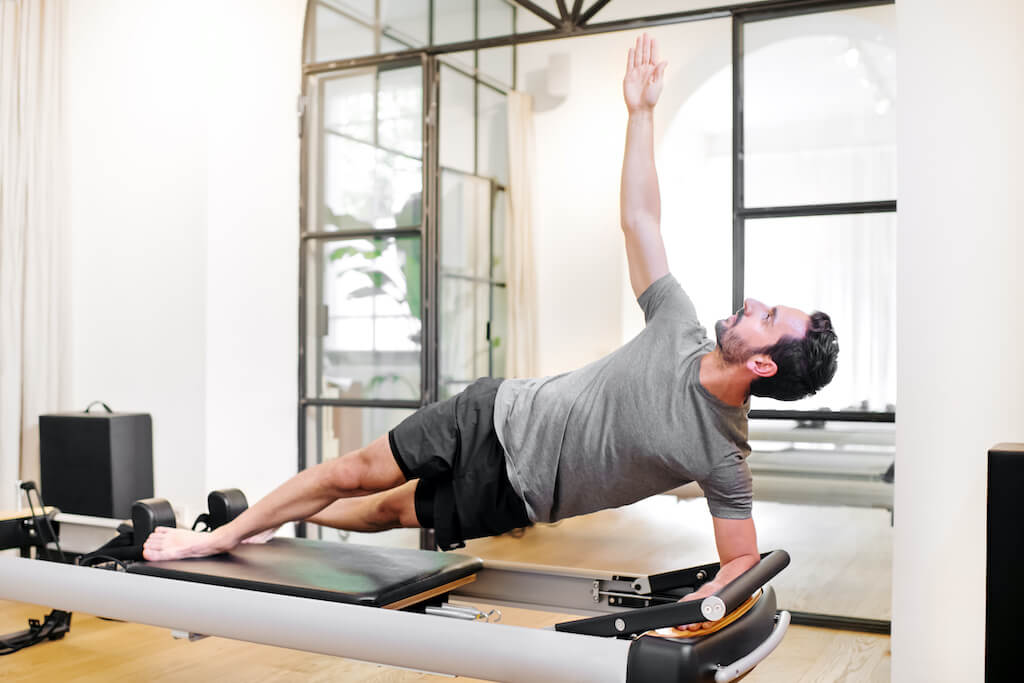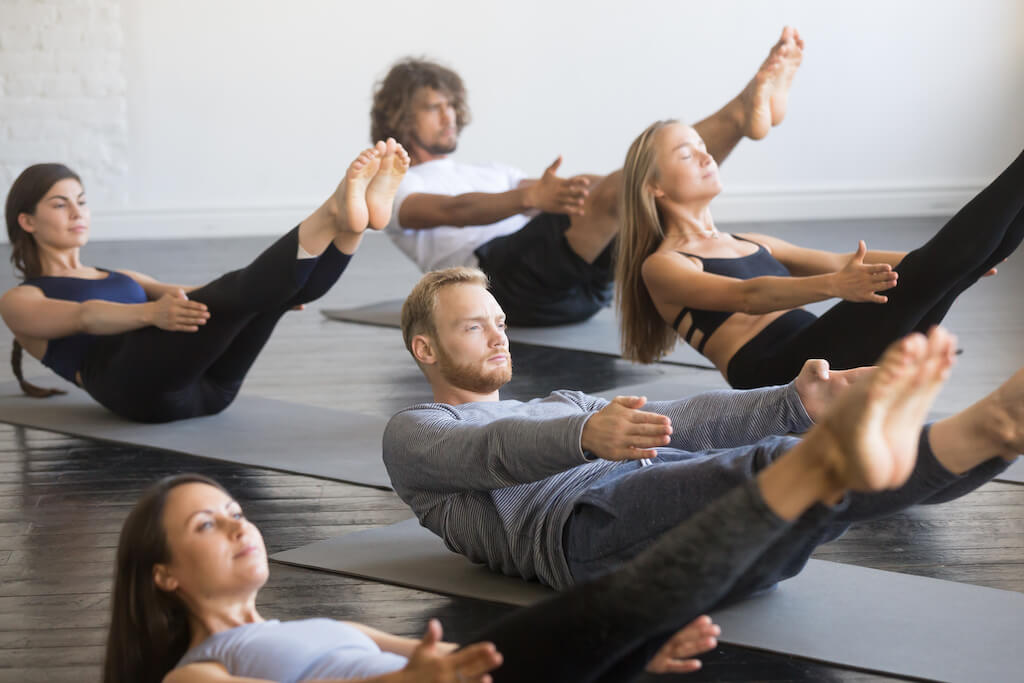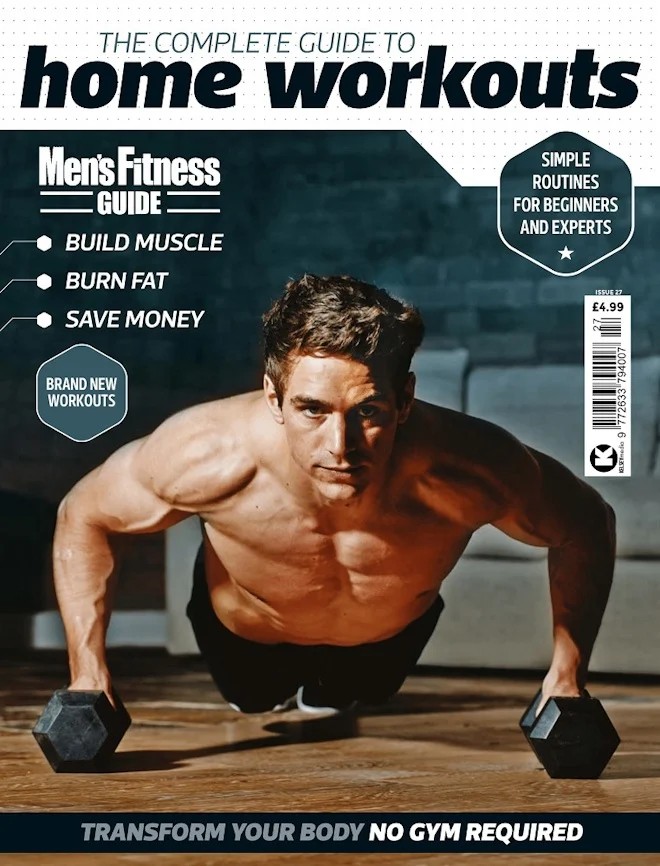Pilates is a bit of a mystery for most men. Many still think it’s something only women do. I know that because when I asked a random sample of male friends (mostly comedians) what came into their heads when Pilates was mentioned, what I got was a range of responses.
I heard references to Pontius Pilates, the Pilates of Penzance and other witticisms even worse than those. Quite a few mentioned farting, including the fear of doing it in public. Lycra came up a lot, as did back and shoulder pain, machines and “big blue balls”. A number of responders brought up yoga or yoga mats or “yoga in an S and M dungeon”.
The most detailed answer was “a rehabilitative practice originally designed to work with dance-related injuries, in which a bespoke programme of exercise is constructed to strengthen the area around the injury”. Which I liked the sound of, even though it’s not entirely correct.
Not a single one of them had considered trying it. And these are not men who are unaware of, or don’t think about, their bodies. One of them plays football with me, some exercise quite a bit and one is a marathon runner. Pilates seems to have almost totally passed them by, and even if they had some idea of what it is, they felt, like I used to, that it was a women’s thing. Which is all a little odd, considering it was invented by a German man who was a boxer, gymnast and bodybuilder – while in an internment camp in England during World War I.
A thinking man’s game
Why are men like this? My theory is that you have to engage with Pilates – explore it. It requires attention and focus, and when it comes to men and physical exercise, we don’t like to think about it too much. We don’t want a lot of instruction. It’s why most men don’t go to ‘matwork’ classes in gyms. We don’t like to feel vulnerable or be confronted with our inability to make a movement that even the most superficially unfit person two rows down seems to be making with no effort at all.
We want to turn up, get changed, do our chosen activity, shower, get changed again and forget about it. It’s essentially a reset. We go in with all this pent-up male energy and aggression and we come out calmer and less angry. It’s like masturbation, but with a competitive element.
I am one of those men. I’m 58 and I still play five-a-side football. I have a running machine at home which is not just used for drying clothes on, and I also play tennis with my 19-year-old son (who’s a tennis coach). Believe me when I tell you that is not easy.
And like everyone who’s active and who regularly gets off the sofa for more than just shuffling to the fridge for a snack, I’ve had muscle injuries, some of them quite serious. I once tore my calf muscle so badly during five-a-side that, the next morning, I fainted near the bottom of the stairs and woke up surrounded by my concerned looking family.
But what happens when you’re that sort of man and you hit your fifties and beyond?
When injuries take longer to heal and the simple act of a quick game of football takes, with warm-up, warm-down and recovery, the best part of three hours and you’re still feeling it four days later.
What then?
Curing the creaks
Three years ago, I injured my hip getting out of the car. Not trying to escape from a burning car, or jumping out of a car before it had come to a complete halt. No, just plain old getting out of the car. My partner, Rosie, dropped me off at the station and as I opened the door and swung my leg out, I felt a pain in my hip. Which didn’t go away for a year and stopped me playing sport (I took up swimming – it’s the only exercise that didn’t hurt too much but it’s SO DULL).
To sort it, I tried all the things I’d done in the past – massages and physio and gels and the like – but nothing worked. It was starting to get to me. Was this the beginning of the end? Had I started down the long slow road to decrepitude?
And then I got lucky. I’d known Hana Jones since 2005. She’s one of the founders of the Pilates Foundation and an extraordinarily gifted Pilates teacher of 40 years standing, who’d mentored Rosie (who’s also now a Pilates teacher). They were observing me from a distance and agreed that my body needed some serious postural realignment, so Hana suggested to Rosie that I should go and do some Pilates with her. I jumped at the chance, and it was the best decision of my life.
What is Pilates
Well, it’s almost easier to say what it’s not. It’s not sport and there are no points. You can’t win at Pilates, at least not against anyone else. If you’re in a Pilates class, you can’t beat the person (metaphorically or indeed literally) on the mat next to you into submission. It doesn’t involve massive amounts of effort and, unless it’s a very hot day, it’s unlikely you’ll be dripping with sweat when you’re done.
Although Hana counters that with, “In actual fact, once you get to a certain level of awareness, physical capacity and technical understanding, it is possible to drip with sweat on a Pilates mat or apparatus class, but it’s a way down the road for you.”
Joseph Pilates never really described it in one sentence. His most famous quote is, “A man is as young as his spinal column,” which is succinct but doesn’t really help in this regard. Hana takes a more philosophical view: “My objective has been to support you to be fully ‘in’ your body, so that it can be a true physical expression of the totality of who you are…”
Which I completely get but it isn’t helpful when you’re in a lift and someone asks what it is.
I’d describe it as controlled and focused movement and breathing, to encourage flexibility and a more efficient use of my body. Not a description to get the blood pumping, but as I get older, flexibility and a more efficient use of my body are things that I definitely need, so I can keep doing the things that do get the blood pumping.
A new man
I’ve been practising Pilates for two years. I do two studio sessions a month with Hana on the apparatus (in the ‘S and M dungeon’ as my comedian friends would have it) and three to four hours self-practice each week.
And there have been some notable and noticeable changes. I feel great, particularly right after a session, but also in general. I’m much more aware of my body than I’ve ever been, I feel stronger, more powerful, possibly even a bit funnier (I may not be the best judge of that). I’m taller, not by much, but just the simple fact of having my head sitting further up and back on my spine seems to have increased my height.
I’m no longer slump-shouldered, my body feels more open, more confident. People who haven’t seen me for a while tell me how well I look, although they can’t quite put their finger on what it is exactly that’s changed. Someone said “more youthful”. I’m enjoying the compliments. Most importantly, I’m still playing five-a-side football and it doesn’t take the best part of a week to recover.
Who knew that was possible?











